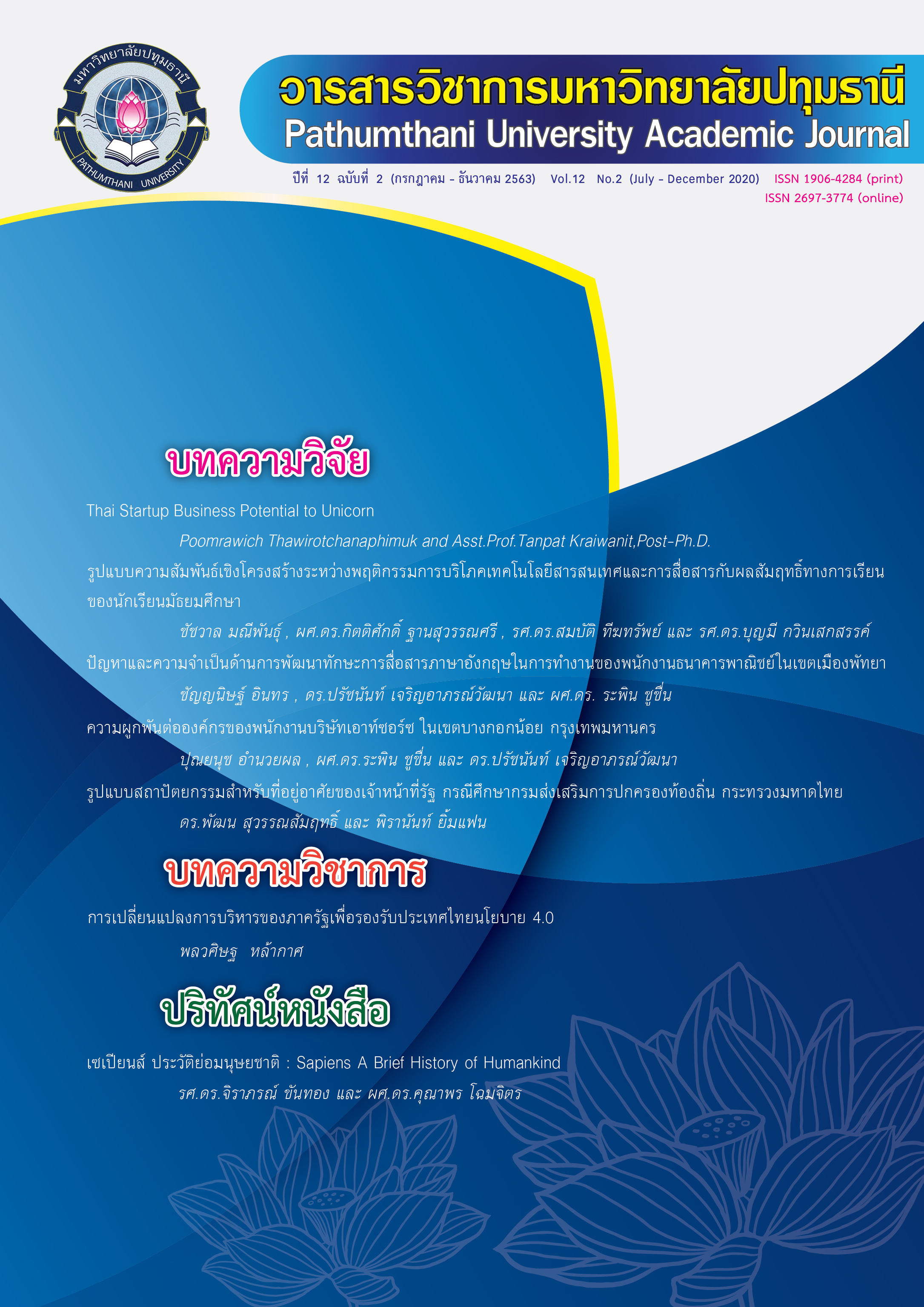CHANGES IN PUBLIC ADMISTRATION IN RESPONSE TO THAILNDS 4.0 POLICY
Keywords:
Public Administration, Thailand 4.0Abstract
“Thailand 4.0” as a policy was formulated by Thai government to move the country from the notorious middle-income trap, income discrepancy and unbalanced development, into sustainability and prosperity, especially in the face of the fourth-generation industrial revolution. The government laid a 20-year plan with focus on inner strength building and connectivity with the world community as part of the triple helix model—cooperation between academia, private sector and governments, to foster economic and social development through a civil state mechanism. Due to extensive involvement from all parties in this model, the state must be reformed into a digital government with improved working process related to the 4.0 policy, extensive participation from the state, implementation of “smart government” idea and mutual integration into value-based economy like developed countries.
References
Decode “Thailand 4.0” .(2016) .New Economy: crossing over the middle-income trap. Thairath. Retrieved 22 April 2020 from http:// www.thairath.co.th/content/613903
Digital Economy Promotion Agency. (2017). Digital Economy Promotion Agency inaugurates Tech Startup Club. Retrieved 10 May 2020, from http://www.depa.or.th/th/newsA7-tech-startup-club.
Dutta, Soumitra, Lanvin, Bruno, and Wunsch-Vincent, Sacha. (2018). The Global Innovation Index 2016: Winning with Global Innovation. Cornell University, INSEAD and WIPO, Geneva.
Jiraprapha Akkarabavorn, Anuchart Charoenwongmit and Jaruwan Yonrakang. (2009) . The management of the changing. 3rd edition. Bangkok: Office of the Public Sector Development Commission. Cabinet and Royal Gazette Publishing Office.
Kasetsat University. (2016) . Blueprint and action plan for Thailand 4.0, driving model for Thailand 4.0 Model to Bring Security, Wealth and Stability to Thailand. Retrieved 10 March 2020 from http://www.digital.forrest.ku.ac.th/TFCC/TCERN 2017/PW/Thailand_4.0_PM.pdf
Koopman, C., Mitchell, M.D. & Thierer, A.D. (2015). The sharing economy and consumer protection regulation: the case for policy change. The Journal of Business, Entrepreneurship & the Law: SSRN Electronic Journal SSRN Journal
Ministry of Industry. (2016). National Strategic Development Plan Thai 4.0 (B.E.2560-2579). Retrieved May 22 2020 from http://www.oie.go.th/sites/default/files/attachments/industry_plan/thailandindustrialdevelopmentstrategy4.0.pdf.
National Productivity Institute.(2018). Thailand 4.0 Country Development Model for Sustainable, Prosperous, and Sustainable Development Retrieved May 15 2020 from http://www.ftpi.or.th/ 2016
Peerasit Patanakul and Pinto, Jeffrey K.. (2014). Examining the Roles of Government Policy on Innovation. The Journal of High Technology Management Research.
Sarel, Michael. (1996). Growth in East Asia: What we can and what we cannot infer (Vol. 1). International Monetary Fund .
Schedler, K. & Proeller, I. (2007). Chapter 1 public management as a cultural phenomenon. S.l.: Emerald Group Publishing Limited.OECD. (2015). OECD Digital Economy Outlook. Paris: S.N.
Software Industry Promotion Agency (Public Organization) (SIPA). (2015).Software market. Retrieved May 12 2020 from
https://www.aripfan.com/sipa-software-market-thai/
Suwit Mesinsee. (2016). Thailand 4.0 . Retrieved 10 April 2020 from http://www.Th-th.facebook.om
Thailand Productivity Institute and the Federation of Thai Industries .(2016). Improvement of Thai Industrial Sector to Accommodate Future Management. Retrieved 10 May 2020 from http://www.Ftpi.or.Th/download/member-le/productivity_world/pw119/p-world-issue119-Nov-Dec-15-Future.pdf/9835.
The Global Open Data Index .(2017).The open statistic .Retrieved on May 18 2020 from http://2015.index.okfn.org/dataset/
The World Bank. (2018). Ease of doing business index Catalog Ease of doing business index. Retrieved on May 10 2020 from https://data.worldbank.org/indicator/IC.BUS.EASE.XQ
The World Bank. (2018). GDP (current US$). Retrieved on February 1 2020 from http://data.worldbank.org/indicator/NY.GDP.MKTP.CD?locations= TH&view=chart.
Thipsarin Pakthanakul and Totsapol Chiaochanprapan. (2016). Open Government Data to Open Government: Innovation in Thailand’s Public Administration in the Digital Era. The 18th King Prajadhipok's Institute Conference (2016), Revitalizing Thai Democracy . Bangkok: King Prajadhipok's Institute Conference,
Wichan Chaiorn (2016). Academic Focus Thailand 4.0. Retrieved on 8 May 2020 from http://dl.parliament.go.th/handle/lirt/493129,2
Woralak Sriyai. (2013). Less racing for government scholarship, focusing more on “crime-disaster”, low brain-drain in face of low wages. Retrieved on 8 April 2020 from http://www.tcijthai.com/news/2013/02/scoop/1984.
World Economic Forum .(2018).The Global Competitiveness Report 2017-2018 . Retrieved on June 12 2020 from https://www.weforum.org/reports/the-global-competitiveness-report-2017-2018
Downloads
Published
How to Cite
Issue
Section
License
บทความที่ได้รับการตีพิมพ์เป็นลิขสิทธิ์ของวารสารมหาวิทยาลัยปทุมธานี
ข้อความที่ปรากฎในบทความแต่ละเรื่อง เป็นความคิดเห็นส่วนตัวของผู้เขียน กองบรรณาธิการไม่จำเป็นต้องเห็นด้วยเสมอไป และไม่มีส่วนรับผิดชอบใด ๆ ถือเป็นความรับผิดชอบของผู้เขียนแต่เพียงผู้เดียว



